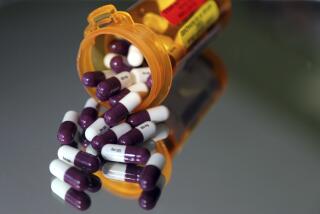Healthcare spending in U.S. slows
- Share via
WASHINGTON — Healthcare spending in the U.S., already the highest in the industrialized world, continued its steady rise in 2007, even as the growth eased slightly to its lowest rate in 10 years.
The mild slowdown -- due in part to less growth in drug spending -- was a rare bit of good news as Washington policymakers begin to debate how to reshape the nation’s healthcare system, a top priority of congressional Democrats and the new administration.
With Americans increasingly squeezed by medical bills, President-elect Barack Obama and others have said they want to control costs, expand insurance coverage and improve the quality of care that Americans receive.
Overall, the nation spent $2.2 trillion on healthcare in 2007, or $7,421 a person, the Centers for Medicare and Medicaid Services concluded in its annual summary of healthcare expenses.
That is 6.1% more than the country spent in 2006. A year earlier, spending jumped 6.7%. The 2007 numbers were the latest available.
Most notable, spending on prescription drugs grew by 4.9%, the lowest growth rate since 1963.
The report’s authors concluded that was largely because of increasing use of generic drugs, which are usually far cheaper than brand-name pharmaceuticals.
The shift to generics has accelerated as a number of blockbuster medications, including Zocor, Flonase and Ambien, lost patent protection in 2006 and 2007.
Generics accounted for 67% of the drugs dispensed in 2007, up from 60% two years earlier.
At the same time, drug prices in general have risen more slowly. High-profile health scares involving prescription drugs in recent years have also depressed demand, said Micah Hartman, a statistician who was the lead author of the report.
Mark Merritt, head of the Pharmaceutical Care Management Assn. that represents drug plans, saw the slowing growth in spending as a hopeful sign that healthcare expenses could be reined in.
“What we are seeing is the camel’s nose in the tent,” Merritt said, adding that speeding up the approval of other generics offers even more opportunities for savings. “This is just a hint of what the future may hold,” he said.
Also restraining spending was slowing growth in Medicare administrative expenditures as the federal government completed the roll-out of the new Medicare Part D prescription drug benefit.
If the slowing rate in the growth of healthcare spending offered some cheer for policymakers, it may come as little comfort to many consumers, who are paying an increasing amount for their healthcare.
In 2007, Americans spent $269 billion on so-called out-of-pocket healthcare expenses such as co-pays and deductibles, 5.3% more than they did the year before.
That was a more rapid increase than in 2006, when spending on out-of pocket expenses jumped just 3.3%, according to the report.
Nor is it clear how the decelerating growth in drug expenditures could translate to the broader health sector.
Spending on prescription drugs accounts for just 10% of the nation’s healthcare budget. Other, larger sectors continued to grow substantially in 2007.
Hospital spending, which consumes three times as many dollars as pharmaceuticals, expanded by 7.3% in 2007, to $697 billion.
Spending for physicians and clinics grew 6.5%, to $479 billion.
At the same time, federal spending on Medicare and Medicaid health insurance programs also continued to rise by more than 6%.
With the economic downturn worsening, lawmakers on Capitol Hill and the president-elect are considering even more healthcare spending to help states deal with the growing number of unemployed losing their health insurance.
--
More to Read
Sign up for Essential California
The most important California stories and recommendations in your inbox every morning.
You may occasionally receive promotional content from the Los Angeles Times.














